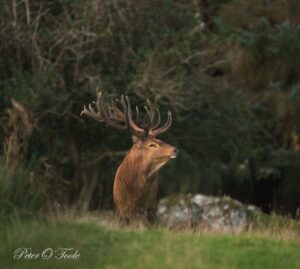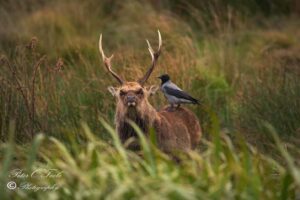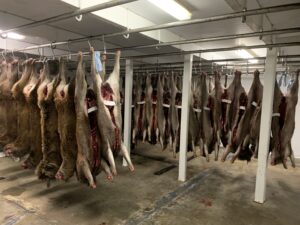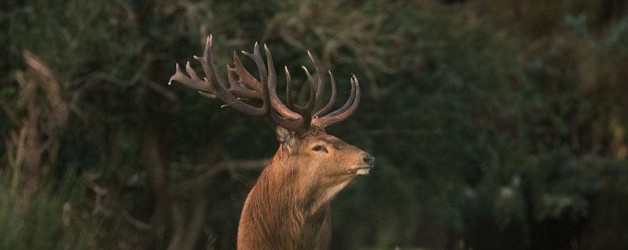
Public Consultation on the Management of Deer in Ireland
A RESPONSE
to an invitation to the Irish Deer Commission by the Minister for Housing, Local Government and Heritage, Darragh O’Brien TD and Minister for Agriculture, Food, and the Marine, Charlie McConalogue TD issued on October 27th, 2022.
Reference: DAFM-MMO-02403-2022
Compiled by
The Irish Deer Commission on behalf of its Executive and Membership
February 10th, 2023
1: INTRODUCTION
1.1: This response follows an invitation to the Irish Deer Commission (IDC) by the Minister for Agriculture, Food, and the Marine, Charlie McConalogue TD issued on October 27th 2022, (Reference: DAFM-MMO-02403-2022) and subsequently by Minister for Housing, Local Government and Heritage, Darragh O’Brien TD issued on December 20th, 2022 following the launch of a Public Consultation on Deer Management in Ireland, and is compiled on behalf of the Executive and Membership of the IDC and seeks to incorporate all those common concerns and views shared by our members.
Concerns have been expressed that the questions contained in the deer management consultation online survey appear to create a predetermined outcome and attempt to portray wild deer in a negative light. Furthermore, the survey format and questions appear to plagiarise the DEFRA (UK) deer management consultation launched in August 2022. While public engagement is to be welcomed on this topic, any decisions regarding deer management should be well founded and scientific based and not simply arbitrary. A deer management strategy should be developed by relevant experts and stakeholder input and not by online surveys.
1.2: IDC is a respected NGO with a national membership from all deer management sectors – licensed deer hunters, both professional and part-time, academic including our scientific advisor Dr Ruth Carden, landowner and forestry interests, or those who have an interest in our wild deer. IDC is an active lobby group and the only Deer Management organisation registered under Lobbying Act 2015. IDC has a close working relationship with stakeholder groups such as IFA Countryside, Coillte Teo and many others. IDC have become the first port of call for regional and national media on deer related matters. IDC host a busy schedule of online events and courses with the aim of promoting and encouraging efforts to improve the management and conservation of our wild deer. IDC operate a national Humane Deer Dispatch scheme where 135 trained volunteers assist the agencies who deal with deer vehicle collisions.
- IDC SURVEY ON DEER MANAGEMENT IN IRELAND
2.1: IDC undertook a survey of its members, licensed deer hunters and those involved in deer management in preparation for our response. The online survey asked participants a series of multiple-choice questions on common issues and suggestions around the management of deer in Ireland. We will refer to the survey findings in our responses. We also held several Executive meetings to discuss this matter in further detail and sought the views of non IDC members.

3: BACKGROUND TO DEER AND DEER MANAGEMENT IN IRELAND
3.1: Deer are a protected species under our Wildlife Acts and an important part of our natural heritage with deer present in Ireland since Neolithic times over 5,000 years ago. Deer at sustainable levels are an asset both economic, visual, sporting and benefit woodland regeneration, however where deer numbers become excessive, they can have negative impacts for farming, forestry, and the wider ecosystem. In the absence of a natural predator, it falls on licensed deer hunters to manage their numbers and support landowners.
3.2: Data supplied to IDC by the National Parks & Wildlife Service (NPWS) show 6,232 deer hunting licences were issued by the Wildlife Licensing Unit of NPWS under Section 29 of the Wildlife Acts in the 12-month period up to February 28th, 2022. The number of licences continues to grow annually due to an increase in the popularity of deer hunting. The number of licenses issued by NPWS grew by 17% in 2022.
3.3: Additional data provided by NPWS to IDC show 55,008 wild deer were culled by licensed deer hunters in the 12-month period up to February 28th, 2022, an increase of 24% on the previous highest cull achieved in 2019. It is important to note this data is based on annual hunter cull returns and not independently verified, however hunter cull returns require the applicant to sign a declaration of accuracy. The actual cull total is believed to be substantially more as the cull total does not include the growing problem of illegal killing of wild deer known as deer poaching, nor does the total include the growing number of deer killed on our roads. Over the last five years over 200,000 wild deer were culled in Ireland under licence from the NPWS and highlights the important-role licensed deer hunters play in managing deer at sustainable levels to minimise negative impacts on farming, forestry, and the wider ecosystem. The most recent data show hunters culled more female than male deer, which is in line with best practice deer management on reducing deer populations. Deer culling is carried out without cost to the state but requires substantial investment in equipment, sporting rights, and other items required to undertake deer management by hunters.
3.4: Despite claims of growing deer populations, in the absence of deer density data, the true deer population is unknown in Ireland. The current levels of annual deer culling may be appropriate, or require additional culling, or have negative consequences for the future conservation status for wild deer due to excessive culling. Anecdotal evidence from those involved in deer management would suggest some localised areas have excessive deer numbers, whereas in most areas’ deer are being managed at a sustainable level. County Wicklow accounted for 36% of the national cull in the 12-month period up February 28th, 2022, with counties Wicklow, Tipperary, Waterford, Cork, Galway, and Kerry combined accounting for 70% of the national deer cull, which suggests high deer densities are limited to local areas in a low number of counties.
Suggestions that the increasing deer cull is solely linked to an increasing deer population should be avoided as data shows the increase in deer culled has a direct corelation to the increase in the number of hunting licences, with the average remaining at 7/8 deer culled per hunter, per open season since 2004.
Restrictions around the management of deer during the Covid-19 pandemic, combined with a worldwide crash in venison prices, delays by NPWS in the issuing of deer culling permits due to Covid-19 working restrictions, poor forestry design for the management of deer, and a rapid expansion of afforestation, all have created the perfect storm for deer numbers to potentially increase in some areas.
IDC survey results – 52% see a decrease or no change in the number of deer in the areas they manage, 41% see an increase, 7% not sure.
3.5: While progress has been made in recent years, deer management knowledge among all stakeholder groups is low, often leading to arbitrary and misinformed claims about deer and their management. There is growing pressure from the farming and other land use sectors on NPWS and the Department of Agriculture, Food, and the Marine to cull more deer, while well founded this approach can lead to misinformed and poor deer management practices and decisions along with creating unintended animal welfare issues and an increase in crimes against deer. The current climate emergency and loss of biodiversity has created additional polarised views around deer, while there is minimum negative views on the impact of other herbivores such as goats, hares, and intensification of farming, have on ecosystems. Knowledge of how deer can be managed to co-exist within a healthy ecosystem or benefit ecosystems is very low among stakeholders.
IDC survey results – What concerns you most about deer management in Ireland, 69% negative and misleading comment about deer, 64% deer poaching (the illegal killing of deer).
- SUGGESTIONS DEER CAN BE MANAGED BY OTHER METHODS
4.1: Contraception using immunocontraception vaccines have been suggested as a method to control wild deer numbers. Studies have found while this can be effective in captive fenced deer herds where all females can be vaccinated safely and venison does not enter the food chain, such an approach is not feasible for wild deer as to prevent population growth all female deer would need to be vaccinated which is not possible as wild deer are free roaming over large areas, a flight animal if approached, and difficult to locate in dense habitat. Furthermore, the venison from vaccinated wild deer can pose a human health risk if accidentally consumed.
4.2: There has been much debate about the introduction of predators such as the wolf or Eurasian Lynx as a means of controlling wild deer number. While the wolf and Eurasian Lynx are excellent predators and a species many would like to see in Ireland, however their introduction would have little or no impact on wild deer populations. The last sighting of a free roaming wolf in Ireland was in 1768, since then we have become an intensive agriculture nation with over 13 million sheep and cattle existing on our small island. Slow moving livestock would make far easier prey for such predators versus a highly adaptable and flight animal like a wild deer. In other jurisdictions the Eurasian Lynx prey on smaller deer species occasionally such as Roe deer which are not present here in Ireland.
- OPEN SEASONS ORDER FOR DEER AND OUT OF SEASON CULLING
5.1: Landowners who suffer genuine crop damage from deer can apply for a permit under Section 42 of the Wildlife Acts to cull deer outside the designated open hunting season (September 1st to February 28th) data shows less than 0.25% of landowners have a requirement for such permits suggesting deer conflict or high deer densities are the exception outside the current open deer season. The months of March and April can be a particular issue when spring grass growth is underway, and deer recovering from the tough winter conditions grazing on limited and valuable grass. However, where landowners do require additional support, the current section 42 process is cumbersome and slow. An online process that allows the hunter to apply with the landowner would support landowners who require immediate and quick deer management support. Section 42 permits for female deer should be avoided, on animal welfare grounds from the months of May to mid-October due to dependent young.
5.2: The current issuing of night permits under section 42 of the Wildlife Acts should be immediately paused until such time as adequate safety measures and training are available. The uncontrolled discharge of high powered firearms at night creates significant safety risks for livestock and those who live in rural communities. In other jurisdictions night shooting is important tool in exceptional circumstances but undertaken in conjunction with local police and requires strict training and safety measures. Night shooting permits in their current format can promote the illegal killing of deer which in turn makes deer management more difficult due to disturbance, in addition the illegal killing of deer often focuses on male deer due to their larger body weights and financial reward for criminals with no benefit to deer management.
5.3: There is no open season for red deer in County Kerry due to their national and international conservation importance, and importance for local eco-tourism. While deer densities appear excessive within Killarney National Park, NPWS have increased culling in recent years, outside the National Park Red deer numbers are low to sustainable. A conservation threat remains from sika/ red deer hybrids in the West Cork area, and non-native red deer in County Limerick. Hybridisation between red and sika deer generally occurs through human intervention and is limited to County Wicklow and a local area in West Cork. Sika and red deer have co-existed in County Kerry since 1864 without hybridisation occurring between the two species.
IDC survey results – 53% oppose any change to the open season for red deer in County Kerry, 17% no view.
5.4: The Open Seasons for wild deer in Ireland are from September 1st to December 31st for male deer, and November 1st to February 28th for female deer and antlerless males, these seasons have delivered significant results in terms of deer management with over 200,000 deer culled in the last 5 years alone. There is no evidence to suggest the current open seasons are a factor where deer number become unsustainable and this is more likely to occur due to one or several factors such as, poor forestry design for deer management, landowner, or neighbouring landowner refusal to allow deer management take place, or disturbance due to excessive hunting pressure, forestry operations, or illegal hunting, which can cause deer to become nocturnal and difficult to cull. Lack of deer management activities in adjoining state land, Coillte property, and private land can also be a factor.
5.5: Best practice deer management requires more female deer to be culled than male deer, culling male deer has a minimum impact on deer populations, as a single male can breed with a high number of females. Many hunters will not cull female deer during the month of February, while females are pregnant throughout the female culling season during the month of February the foetus of the unborn young is developed and visible during the processing of the carcase after culling. For deer managers who need to cull larger numbers of deer this tends not to be an issue however culling female deer beyond February is likely to be unpopular and have a reduced impact due to lack of culling. Potentially females could be culled from late October to the end of March. If we look at open seasons in other jurisdictions such as the UK, female deer are culled from either October 21st to February 15th (Scotland) or November 1st to March 31st. (England, Wales, Northern Ireland) New-born deer are dependant up to the middle of October, while in other jurisdictions, culling of dependant young and female together is required, this is difficult to achieve in a woodland setting. An alternative approach to ensure animal welfare is maintained would be to keep the November 1st start date for females, and close a month later on March 31st. Any extension to the male season would have very little impact on deer numbers and remove the focus on culling females in line with best practice deer management.
IDC survey results – 68% would support a change to the open seasons for deer

6. RECLASSIFCATION OF DEER AS AN INVASIVE SPECIES
6.1: Deer are currently protected, under our Wildlife Acts, any attempt to reclassify as an invasive species or remove their protection under the wildlife acts would be contrary to their importance in the countryside and deer management. Deer are a highly adaptable species and react to hunting pressure or disturbance by moving to new areas or becoming nocturnal. Fallow and Sika deer have been the subject of ill-informed comment regarding their status and hold an important status in our natural heritage, present in Ireland since 1164 and 1860 respectively, introductions of Sika deer in other jurisdictions, are more recent and seen as invasive. Any reclassification of wild deer would damage the reputation of venison and undermine any attempt to develop the venison market, which is a prerequisite of sustainable deer management.
Reeves Muntjac deer are classified as an invasive species however we have not seen any evidence of their existence since 2011 following the escape of a captive herd in County Wicklow. Reports of Reeves Muntjac deer in hunter cull returns are generally accidental identification and not verified by NPWS.
IDC survey results – 76% oppose any reclassification or removal of protection for deer.
- DEVELOPMENT OF THE WILD VENISON MARKET IN IRELAND
7.1: A vibrant wild venison market is a prerequisite to sustainable deer management. While venison is a super food in terms of health benefits, sustainable, and organic, the demand for venison in Ireland is low. Our survey results show 77% of respondents consume all the venison they cull however this does not equate to 77% of the deer culled as closer analysis of the deer cull data show the 80/20 rule applies to the number of deer culled to hunters. A significant number of deer culled in Ireland are exported in fur to the UK by Approved Game Handling Establishments (AGE’s) with a small Irish market for processed venison.
The capacity of AGE’s is limited and regular price decreases or temporary closure to new carcase are a common feature which have significant consequences for deer management. Some AGE’s will not accept Sika females, calves, or yearlings due to carcass weight, which restricts deer culling.
Venison is a high value meat and will complement our existing meat industry, any attempt to downgrade venison as a secondary meat will have negative consequences for deer management.
7.2: Regulation (EC) No 854/2004 and related legislation control the sale and processing of game in Ireland, the “trained hunter” exemption allows qualified hunter sell game in fur or feather to AGE’s and inspect the carcase as fit for consumption, however qualified hunters are unable to sell small quantities of game to commercial establishments such as restaurants, this is contrary to other jurisdictions and acts as a barrier to the sale of game and promotion of venison. Significant demand and markets for venison exist in Europe and should be explored by government as an additional outlet for wild venison.
IDC survey results – 81% of respondents believe government should do more to develop the wild venison market in Ireland.

- INITIATIVES TO PROMOTE DEER MANAGEMENT IN IRELAND
8.1: Local Deer Management Groups are considered a best practice approach to deer management, and work when the group is inclusive of all stakeholders regardless of views. Such group require a strong coordinator to manage sectorial views and objectives, against sustainable deer management, and must be transparent regarding ongoing deer management.
IDC survey results – do you support local deer management groups inclusive of all stakeholders and views, 70% Yes, 15% No View.
8.2: Community Larders are proven to promote deer management and community involvement in other jurisdictions. Such “off the shelf” larders are normally located on property controlled by the community or local authority with the support of a local caretaker and oversight committee. Additionally, such larders can be provided by relevant trusts on private landowners with part funding from government, trusts, and other interested parties. IDC have made enquires with AGE’s on this initiative with a broad welcome and commitment of support, larders located in areas of known high deer densities.
IDC survey results – do you support community larders to promote local deer management, Yes, 67%, No View 17%.
8.3: Contract culling is a deer management method used in other jurisdictions where government fund specific commercial business to cull deer under contract with government negotiating contracts directly with AGE’s however landownership in these areas tends to be large estates or areas of state forestry, in Ireland ownership tends to be small holdings with culling on state forests already contracted. Currently over 55,000 deer are culled annually without cost to the state. Financial incentives to cull deer could potentially cause an increase in the illegal killing of deer.
IDC survey results – do you support government funding contract deer culling, No 59%, No View 14%
- BARRIERS TO DEER MANAGEMENT IN IRELAND
9.1: Our Wildlife Acts do not support modern deer management in other jurisdictions the use of modern tools such as deer calls to attract deer, or handheld thermal technology to identify or count deer are the norm for deer managers and greatly assist the number of deer culled and understanding of deer numbers in an area, however our Wildlife Acts make using these tools an offence.
IDC survey results – do you believe our Wildlife Acts support modern deer management, No 68%, No View 16%.
Ends.
Irish Deer Commission, February 2023
Content and text should not be published without permission of the Irish Deer Commission
For further details on how to apply for IDC membership CLICK HERE

